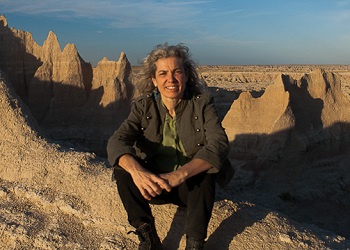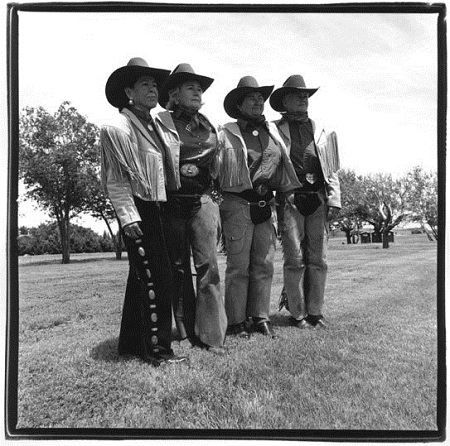"I'm not interested in documenting man's cruelty to man. We see so much of that in the media. I am interested in highlighting the women -- they are the stronger sex in so many ways. Whenever I see something going on in the world, on our TVs, in the papers, I ask, where are the women? Even in the worst and most dire conditions, who is in the background holding everything up? It's generally the women. They are the backbone of every culture and society. I feel strongly that we need to bring those images to the forefront," photojournalist Ronnie Farley stated in answer to my question about why her work throughout her career has concerned itself chiefly with strong women."

Photo by Archana Sahgal
Farley's work can currently be seen at the Howland Center in Beacon, New York. The Howland is featuring an exhibit of her work with cowgirls, Cowgirls: Contemporary Portraits of the American West until the end of January. Over 30 gripping portraits in black and white are on display at the gallery, all from Farley's titular book published in 1995, praised by the New York Times: "Although the subtitle suggests this tribute is purely pictorial, the accompanying narratives are as engaging as Ronnie Farley's stunning photographs; both rescue cowgirls from rhinestone-studded stereotypes and document the gritty realities of Western life." The Cowgirls photographs were also featured in a traveling exhibition throughout the United States between 2007 and 2011 organized by Exhibits USA, sponsored by the Mid-America Arts Alliance and the National Endowment for the Humanities on the Road.

Cowgirl Hall of Famers Fern Sawyer, Jerry-Ann Portwood-Taylor, Ruby Gobble and Gretchen Sammis, Hereford, Texas, 1992.
Photo by Ronnie Farley
Cowgirls is one of three books Farley has published thus far in her long career as a photojournalist. The others are Women of the Native Struggle: Portraits and Testimonies of Native American Women (Crown, 1993) and Diary of a Pedestrian: A New York Memoir (Third Eye Press, 2004). Her work has been shown both nationally and internationally and has appeared in many publications including USA Today, Sierra Magazine, Rolling Stone, the Village Voice, and The Sunday Times of London. She's currently working on a project about water issues in indigenous communities in North America. Black and white film is her preferred canvas:
"There's a depth and soul to film. The process of film is also tactile. I think the ability to create something and hold it in your hands is the most rewarding aspect of any kind of creativity. While digital gets the job done, it's more austere. It's all broken down into numbers, and there's no guarantee your image is going to survive in the form in which it was originally captured. Film is more true to the universal physicality of life -- the waves and particles."
Farley started documenting her life at age eleven when she was given an instamatic camera on her birthday. The youngest of five children, she grew up in the 1960s during a time of turbulence and change. With a father who was the dean at a local university, the dinner table discussions about Vietnam, civil rights, the environment, and women's liberation both inspired and fueled the mind of the shy little girl with a camera who loved nature. Her mother started the Democratic Party in Ronnie's town in upstate New York. "She took on issues no one dared take a stance on at the time," said Farley. "She also started a book club for the local women, and encouraged every woman to educate herself."
A few years ago, Farley self-published Diary of a Pedestrian, an intimate pocket-sized monograph which documented her lengthy walks around Manhattan over a period of 20 years. The black and white images are moving and arresting in their simplicity and capture a rapidly changing city between the late 70s and the late 90s. After having had two books published by divisions of Random House, this was Farley's first foray into self-publishing. She soon discovered that the biggest challenge in such a venture is the distribution. Without the muscle of a big publisher behind the product, it proved almost impossible to get into a major bookstore chain like Barnes and Noble. After submitting it to their Small Press Department, Farley received a letter stating in part:
"The production values of the book are not competitive with other books in the marketplace in this category. The book appears not to have been either professionally designed or edited. Please visit your local bookseller and examine the design elements of other books in this category."
Farley had designed the book herself with the input of every graphic designer she knew and had the book printed by high-end fine art book printer Stinehour Press, as well as engaged the services of a copy editor with a Ph.D. in linguistics from Oxford University. She decided to follow the advice in her Barnes and Noble rejection letter and went to the local store to check out the photography section. "There were 10 Barnes and Nobles in Manhattan at the time, and it was the Christmas season," she told me. Farley decided to surreptitiously place a few copies of the book in both the New York and the photography sections in every store location.
"I would return every few days and monitor which shelf categories were more successful in which neighborhoods. When one book got sold, I'd replace it. If my books got dog-eared, I'd replace it with a new one. If there was a special display devoted to New York or photography, my books were there alongside the best of them. I wasn't sure if I was doing anything illegal. I wasn't taking anything. But I also was discreet and was conscious of all the cameras around me as was doing the deed."
She even bought the book herself to see what would happen at the cash register. When the bar code didn't scan, the cashier manually typed in the code and concluded the sale. "I kept this up well beyond Christmas, and at one point, an employee at one of the downtown stores liked my book so much, I found it prominently displayed in the photography section and shrink wrapped," Farley laughed. A couple of months later she received a phone call from the offices of Barnes and Noble to advise her they were updating their computer system and wanted to clarify the book's title, ISBN number, and price. Farley answered everything just as if Barnes and Noble had actually stocked the book. "It wasn't about the money -- I never made a dime. It was about reaching the public. I felt I had a product worthy of a greater audience. I knew enough people who knew what I was doing and went and supported my cause and bought the book at Barnes and Noble, and told others to do so as well."
Farley currently makes her home in Beacon, and is energized and inspired by the strong arts community in the Hudson Valley.
"The Hudson Valley has inspired artists for centuries. There is a special light here, and of course the Hudson River is a very special river. There's such rich history and beauty. Beacon is a unique city with a diverse and creative population. I have been all over this country for the past thirty years and have traveled somewhat overseas, but have finally found 'home' in this little community. My heart and spirit align here like no other place on Earth."
Farley has a few different projects in development besides the water issues in North America's native communities. She continues to document Native American women and their families, saying:
"What most American do not realize is that the
Additionally she's collecting interviews and portraits of eighty people over eighty years of age for a new book. "We are losing so much wisdom and knowledge with that generation."
I asked Farley if she thought the new technologies and social media advances of the last two decades had helped or hurt us. She inferred that she was somewhat on the fence about it, acknowledging that the new digital age had made it much easier for us to share our visions with others and even start major revolutions.
"I think the most important factor is that while it makes sharing our work faster and easier and gives us more outlets to make a living, we are also destroying our planet with our technological obsessions at an alarming rate. Everything requires us to plug in. All these gadgets we use require destructive mining practices and enormous amounts of water for their production. It's also created techno-addicts out of some of us, who can't survive long without looking at a screen and texting somebody. It is destroying our ability to be in the moment."
Farley concluded, "I believe life speaks to us in the moment -- we have to be open and aware to see and receive these gifts that guide us through life and enrich our experiences."
Ronnie Farley's work can be seen and purchased from her website and here.